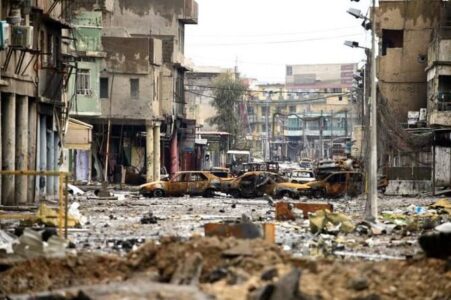
The Islamic State is alive thanks to the Iranian’s militias
The territorial defeat of Daesh was simply the first of a long series of phases needed to destroy the terrorist organization and its ideology completely. This may be the first time a US-led campaign has knocked down buildings and destroyed cities and claimed victory over a terrorist insurgency. But Sunni insurgencies are not defeated by punishing Sunni population centers and destroying cities in bombing campaigns.
Insurgencies are grown when a sectarian government indiscriminately targets and disappears Sunni males in the tens of thousands. The children of non-affiliated Sunni males killed or imprisoned while awaiting execution for being Daesh collaborators will grow up to seek revenge. They do not have to believe in a terrorist ideology to use the group as a vehicle for revenge.
The way Sunni areas of Iraq were destroyed in the anti-Daesh campaign simply reset the conditions that led to the terror group to begin with. The Iraqi government and the militias that destroyed Sunni towns, with US air power in support, took territory away by destroying city blocks and infrastructure. But Daesh can now conduct an attack anywhere in Iraq.
Reconstruction is lagging in the destroyed Sunni areas of Iraq by design. Sunnis are not being recruited into the ranks of a uniformed force to hold territory and secure the population in areas previously controlled by Daesh. The thinking in Baghdad and in prominent think tank sectors of Washington — both are wrong — is that Sunni and Kurdish areas are best when governed by Shiite forces; after all, it’s the Sunnis and the Kurds that are causing problems. This argument does not work and fails with the Shiite youth protest movement joining the ranks of the disenfranchised and Iran’s militias running rampant across Iraq.
In the case of Iraq, the forces operating in these disenfranchised areas are not Iraqis that happen to be Shiite and wear the uniform of the Iraqi Army or the Iraqi Police — they are the militias, more loyal to Tehran than Iraq.
The Iran-backed militias see every military-aged Sunni male as a future Daesh fighter or a former or future Daesh collaborator. They do not know these Sunni areas, they do not know the tribes, they are not trusted, and they treat Sunnis as cells that are ready to be infected with the Daesh disease. The distrust between Iraqis from all sects and these Iran-backed militias is currently the highest it has ever been, and Daesh is watching.
If we could go back to 2013-14, right before Daesh rolled into Mosul, we would see the same conditions present today: An oppressive sectarian government disinterested in the disenfranchised Sunnis of Anbar, Salah ad Din, Diyala and Nineveh provinces; a government that is unanswerable to the disappearance of tens of thousands of Sunnis at the hands of security forces stretching from Jurf Al-Nasr to Ramadi and Tikrit.
The coalition bombing campaign in Iraq and the clearing operations in Ramadi and Mosul destroyed whole sectors of these heavily populated cities. The operations killed tens of thousands and forced 2 million Iraqis to leave these cities and join the internally displaced refugee population.
At no time during the campaign were Sunni military-aged males empowered by Baghdad or the US to take on this Sunni terrorist threat. The lessons of the 2007 Surge, when the US empowered Sunnis to take back their neighborhoods from Al-Qaeda and Iran-backed militias, were shelved. Instead, the US effectively acted as the air force for Qassem Soleimani’s militias.
US Central Command assesses Daesh as being as strong now as it was right before it occupied Mosul with 2,000 fighters. US officials believe there are thousands of Daesh fighters operating in the ungoverned spaces along the Iraq-Syria border. The caliphate is alive and well, as it now operates along the lines of the Al-Qaeda model in Iraq and Syria, while also holding and gaining territory in the ungoverned spaces of the Sahel region of Africa.
But who is actually paying attention? The US is more focused on protecting its forces from Iran-backed militias than going after Daesh. The militias themselves aren’t focused on Daesh — they are focused on killing and disappearing Shiite youths in the protest movement, on defending their headquarters in Shiite areas from these protesters, and on moving arms and forces into Syria. Last but not least, they are also attacking the US missions in Iraq and Syria and attempting to force the US out of Iraq.
Daesh is taking advantage of the coronavirus disease, the distrust of militias, protests, and a security situation where the US and its supposed partners have ceded territory in Sunni areas and along the Syrian border to Iran-backed militias. The Iraqi government and the US continue to take their eyes off the ball.
The US will carry on developing intelligence to target Daesh cells and key leaders, but what is growing now in the unprotected Sunni areas of Iraq and Syria is a pool of young recruits left without answers or a say in a country that has moved on. They want justice and they want revenge against Baghdad, Tehran and the US.
To ensure the enduring defeat of Daesh, the US must put pressure on Baghdad to bring Sunnis into the uniformed military to operate in areas where the terror group survives, due to the local population’s distrust of the militias. The US must pressure Prime Minister Mustafa Al-Kadhimi to disarm and force the Iran-backed militias out of the security apparatus, as well as reform the electoral law and hold free and fair elections.
The US must also pressure Baghdad to allocate and expedite funds toward reconstruction in destroyed Sunni areas. These recommendations are the only way to keep Daesh from learning from its lessons and applying them to wreak havoc at a time of its choosing. The current situation is making this a likely scenario — a very dangerous yet avoidable one.
Source: Arab News





